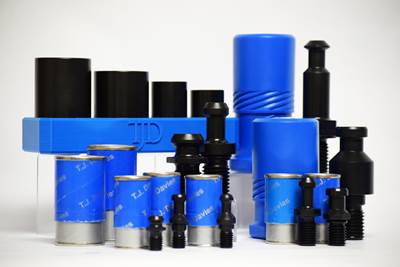Aerospace
Aerospace machining is frequently characterized by the tight tolerances and hard-to-machine metals typical of aircraft engine components, as well as the complex contours typical of both turbine blade forms and the aerostructural components making up a plane’s form. Because machined contours are so typical, five-axis machining is routine in this sector, include large-travel five-axis machine tools able to accommodate the largest aircraft structural components. Materials typical of aerospace machining include lightweight aluminum for structural members; hard and temperature-resistant metals including titanium and Inconel alloys for engine parts; and carbon-fiber composites that are both hard and lightweight for outer skins. Along with large five-axis machines, turn-mill machines and precision grinders are among the high-value machine tools routinely used in this sector.

Latest Aerospace Articles
VIEW ALLForkardt Hardinge Swiss Workholding Provides Reliable, Consistent Performance
The company’s Swiss collets are designed to securely hold parts without marring surfaces, minimizing vibration to ensure smoother machining, enhanced accuracy and extended tool life.
Read MoreJR Machine Launches Expansion Strategy, Hires New CEO
An investment from Schneider Resources Holding positions JR Machine to grow in emerging markets such space exploration and green energy.
Read MoreSandvik Coromant Inserts Provide Stable Turning of Aerospace Components
The new insert grades GC1205 and GC1210 cover a large application area within last-stage machining and intermediate-stage machining when turning aerospace engine components.
Read MoreT.J. Davies Retention Knobs Harden Over Time
Each retention knob is magnetic particle tested and pull tested to 2.5X the pulling force of the drawbar it is designed for.
Read MoreHow Small Machine Shops Can Fight Supply Chain Problems
Supply chain disruptions are still presenting challenges in manufacturing. This article examines the effects on aerospace, automotive and medical industries. It also covers ways that machine shops can be successful securing work despite the challenges created by the supply chain.
Read MoreA Small CNC Machine Shop’s Journey to CMMC
Achieving Cybersecurity Maturity Model Certification (CMMC) — soon to be required to do work for the U.S. government — takes time and money. This 10-person shop takes us through some of the challenges it has faced and lessons it has learned on its CMMC voyage.
Read MoreLatest Products
Titanium Machine-Ready Blanks
TCI Precision Metals’ titanium machine-ready blanks that cut the overall cost of producing parts are available in custom sizes from plate to forged block.
Read MoreFeatured Posts
What’s Ahead for the U.S. Metalworking Economy?
Although previously robust, the U.S. metalworking economy has softened in recent months. However, the overall outlook remains strong. Even a possible 2023 recession does not appear to be an obstacle to continued growth over the next few years.
Read More4 Considerations for Aerospace Component Cleaning
These pointers for aerospace cleaning can help companies understand best practices, safety and determining part cleanliness.
Read MoreCutting Tool Insert Options for Turning HRSA Materials
Consideration of the types of tools used to turn heat-resistant super alloys commonly used for aerospace components is a necessary part of developing an effective machining process for those materials.
Read MorePrecision Laser Measuring in a Grinding Machine
This laser measurement technology inside a grinding machine presents numerous advantages including noncontact, multiple-diameter measurement with no mechanical setup required.
Read MoreThread Milling Tips for Tricky Aerospace Materials
Compared to tapping, thread milling offers advantages for creating threads in challenging materials such as high-temperature alloys.
Read MorePMPA's Market Insights for Automotive and Aerospace
Check out the latest sales insights, prepared by the PMPA, on these top industries served by precision machining industry.
Read More

.jpg;maxWidth=300;quality=90)





















